Vented dryers are designed to expel hot, moist air produced by the dryer to the outside of the home through a hose. Condenser boxes like the one below aim to make vented dryers functional without that hose leading outside.
If you cannot or do not wish to vent your dryer outside, unfortunately, condenser boxes are not the solution. In this article, I will tell you why this is the case and provide you with an alternative and much better solution.

Tumble dryer condenser boxes are ineffective. They also contravene the IRC, which says that, with the exception of approved ductless models, dryers must vent through the outside. Venting outdoors prevents moisture and heat damage to the home and ensures that the dryer does not affect indoor air quality.
How Does a Dryer Condenser Box Work?
Dryer condenser boxes are simply plastic containers connected to a vented dryer’s exhaust terminal via a hose.
The idea is that, instead of entering the ductwork and being conducted outside, the air from the dryer’s exhaust terminal enters the hose and fills the container. The hot, moist air cools in this container, the water condenses out, and the lint is deposited in the water and onto the sides of the container.
Once the air trapped in the container is cooled and the moisture has condensed out, you can take off the lid and empty the water down the drain.
You don’t have to install ductwork and you don’t have the exhaust simply filling your home. That’s the idea, anyway. In reality, they are not very effective.
Components of a Condenser Box
Condenser boxes are a very simple system intended as an “alternative” to dryer ductwork.
A condenser box kit consists of roughly four parts:
- A plastic container (either a whole unit or with a lid).
- A plastic flexible duct hose.
- A few connectors for the dryer-to-hose join (so that it will fit your appliance).
- (Sometimes) A large zip tie to secure the other end (or both) of the hose.
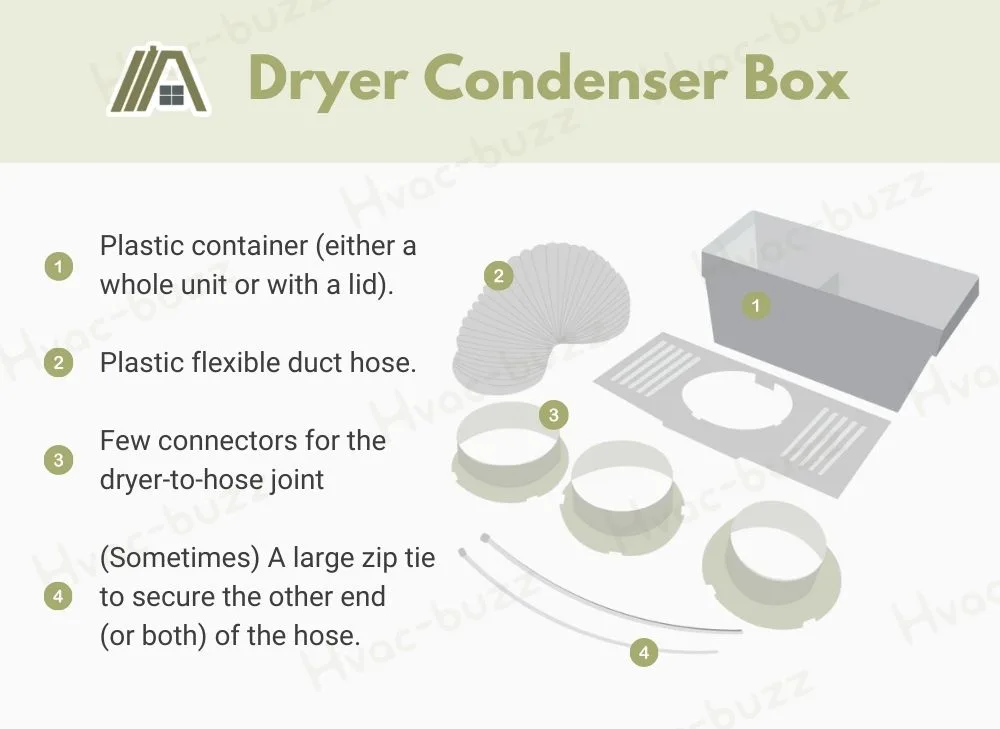
These boxes are designed to catch the water that is exhausted from the dryer and the lint that accompanies it.
The idea of a condenser box is that you do not need to install ductwork for the dryer by allowing the appliance to vent into the plastic box instead of outside.
People have even been known to make their own condenser boxes using a length and diameter of hose that matches their dryer and a plastic tub with a lid.
It’s constructed by cutting out a hole in the lid and sealing (with glue and caulk) in a hose connector. Not forgetting a couple of vent holes.
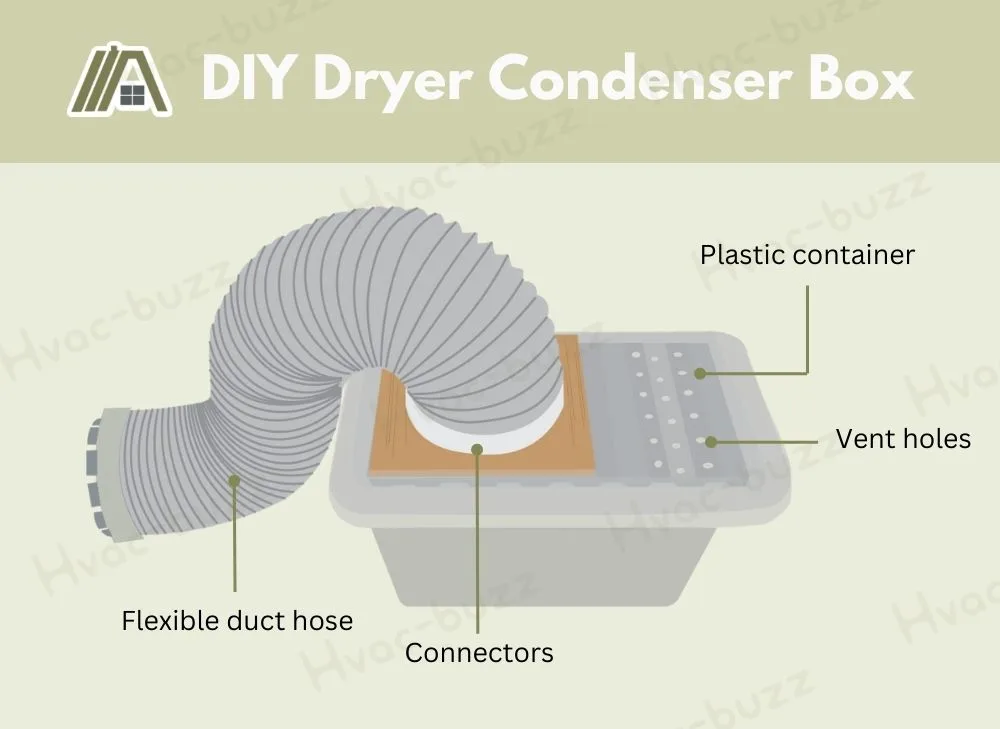
Dryer Exhaust Enters Box
A dryer works with a cycle of airflow as part of its drying function.
First, air is pulled in over a heat source, where it gets hot. Next, that heated air is blown into the tumbler and through the clothes, where it can evaporate moisture.
Air is then pushed out the drum, through a lint filter, and into a vent where a fan sends it through another vent that leads outside the machine.
This vent terminal is normally connected to the exhaust duct at the back of the appliance, which leads outside.
When you have a condenser box, the dryer is, instead, connected to a hose that leads to the box. So, the dryer exhaust is deposited into the condenser box.
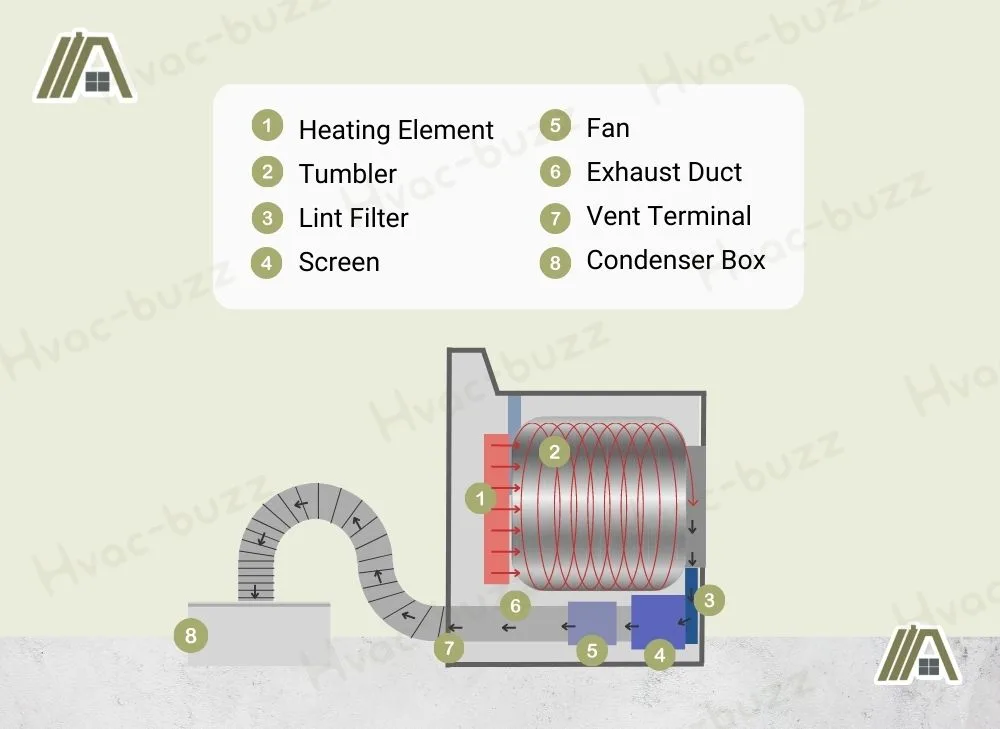
Air Cools in Box
Once in the condenser box, the air begins to cool. As it cools down, it loses its ability to retain as much evaporated moisture as it does when it is hot. This results in water droplets being deposited on the interior surfaces, and condensation collects in the box.
As the air slows (it slows when no longer agitated by additional exhaust entering the box) and its moisture is lost, the air also deposits lint. So, along with water, you will find lint in the condenser box.
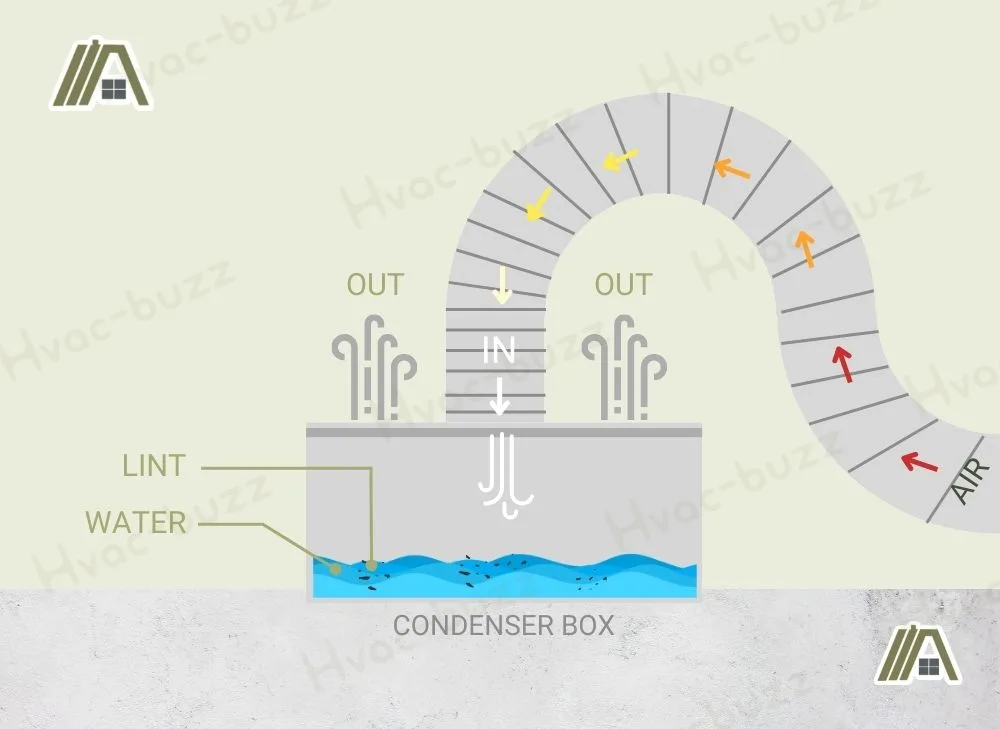
Unfortunately, whatever seals may or may not be present on such boxes, they are not sealed tight against air or water, and the hose connections aren’t typically sealed.
As mentioned earlier, to make your own box, you must add ventilation holes to prevent the lid from popping off from the pressure. There are also ventilation points on the kit containers.
This allows air and water to escape the box, resulting in water damage and increased humidity in the room.
This is also why condenser boxes should never be used for gas dryers that vent harmful gas by-products.
Box Is Emptied
Once the exhaust has settled in the condenser box, you need to empty the water after each dryer cycle. You can do this by removing the hose/lid of the box, taking the base, and pouring the water and lint out at a drain.
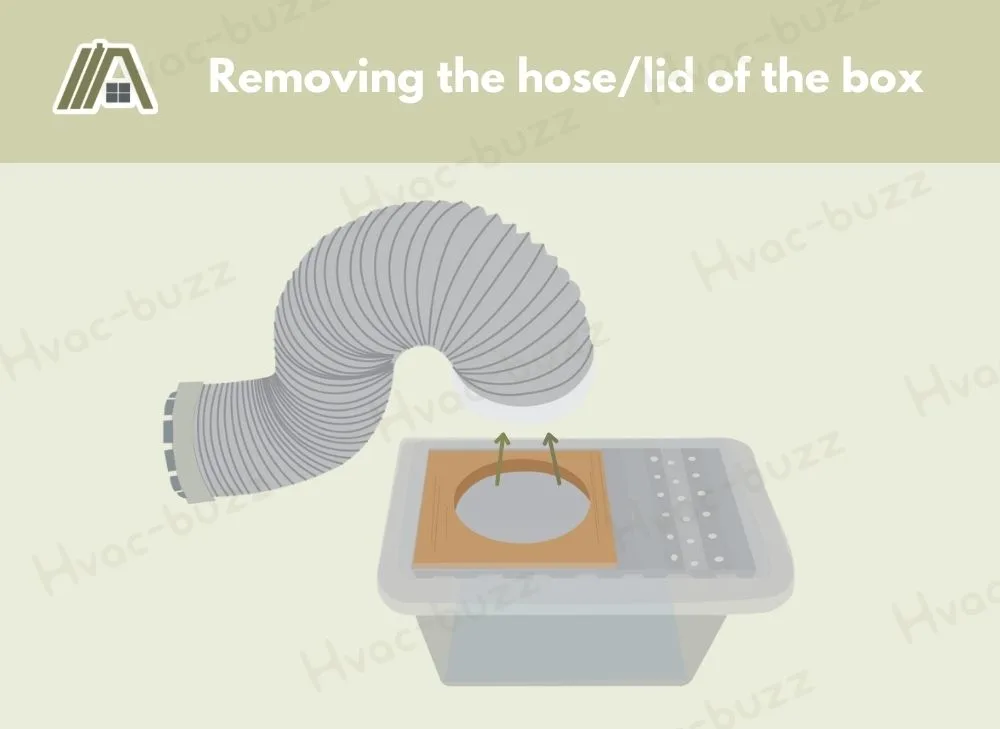
The loss of steam through the ventilation holes, however, may mean that emptying the box is not actually required after every dryer cycle.
By comparison, when a dryer is connected to an exhaust duct that terminates outside, all the lint, moisture, and heat are removed to the outdoors. Therefore, a duct doesn’t require emptying after each use.
While clearing out any lint from the ducting is recommended to maintain efficiency and safety, this only needs to be done every few months compared to the constant need to empty a condenser box.
You will also need to clean up the mess of spilled water, clear out the flexible hose that isn’t smooth to prevent lint from gathering, and keep the box on a surface that the water and heat won’t damage.
Most People Think Condenser Boxes Are Ineffective
It is important to remember that vented dryers are not designed and built to be used with a condenser box. These dryers are made under the assumption, and even the condition, that their troublesome air will be expelled outside of your home and not into a small box inside.
The consensus on condenser boxes across the web is critical. Many people complain of the minor yet annoying problems that come with trying to use two devices together that are not made for each other.
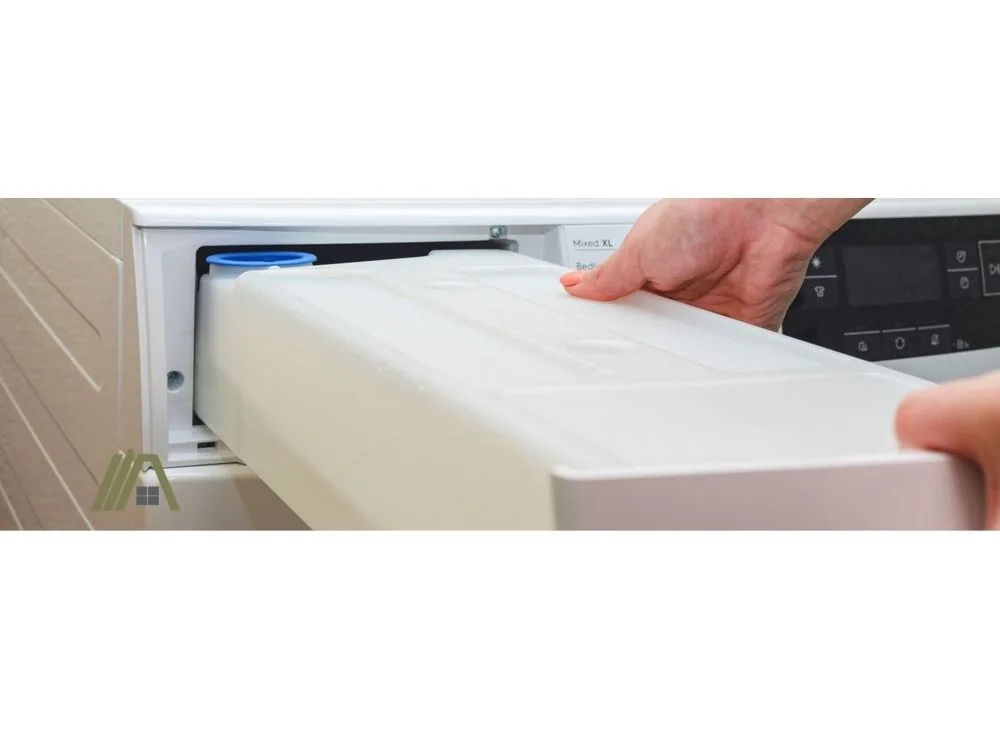
For some users, finding a condenser box with a hose that fits the dryer can be a burden. A hose too small will not fit, and a hose too large will allow the dryer’s air to leak through.
Other users feel that a small box simply cannot trap all of the air a dryer needs to expel. Many share stories of walls wet to the touch and rooms noticeably humid after only one cycle using a condenser box.
The vast majority of reviewers across the web recommend simply venting the air outside (even if it’s just through a nearby window) or buying a condenser dryer instead.
Why Dryer Condenser Boxes Are Ineffective
If you think about it, any container that you purchase or rig up will have to be perfectly airtight to ensure that no air escapes before it has been cooled and the water condensed out. But the container also has to have at least one opening for the hose to attach.
If this connection is not perfect, air will leak out, but if this is your only opening, then you also have to be able to easily detach the hose to empty the water, and the more you handle, it the more wear and tear. This compromises the seal over time.
In addition, the container is not going to be large enough. Consider this, the air being exhausted is the air that filled the dryer drum. Is your container as big as the dryer drum?
But that is also not likely to be large enough to handle all the exhausted air. Vented dryers take in new air each time they vent a drum-ful of air out, and they do this several times during a cycle.
Now, air is compressible, so to a large extent, you can fit a lot of air into a smaller space. However, the more air you force into the container, the greater the pressure inside the container. This can put strain on all weak points, including the opening mechanism and hose connection point.
It also means that the pressure inside the box may start to exceed the pressure of the air being forced through the hose. If there is no proper valve in place to prevent backflow, then the air can eventually start building up in the hose and in the dryer. This affected efficiency and can also be dangerous.
While negative user feedback and the practical reasoning behind it might be enough to deter some people from utilizing this technique, there are others who might still like to give it a try. However, I don’t recommend this because, on top of being ineffective, condenser boxes are also a building code violation according to the International Residential Code (IRC).
Building Codes Require Dryers to Be Vented
Section M1502.2 of the IRC states:
“Dryer exhaust systems…shall convey the moisture to the outdoors.”
Just in case there was any confusion with this one, the IRC reiterates this point in Section M1502.3:
“Exhaust ducts shall terminate on the outside of the building.”
So technically, dryer condenser boxes are not in compliance with the residential codes applicable throughout most American states and other parts of the world.
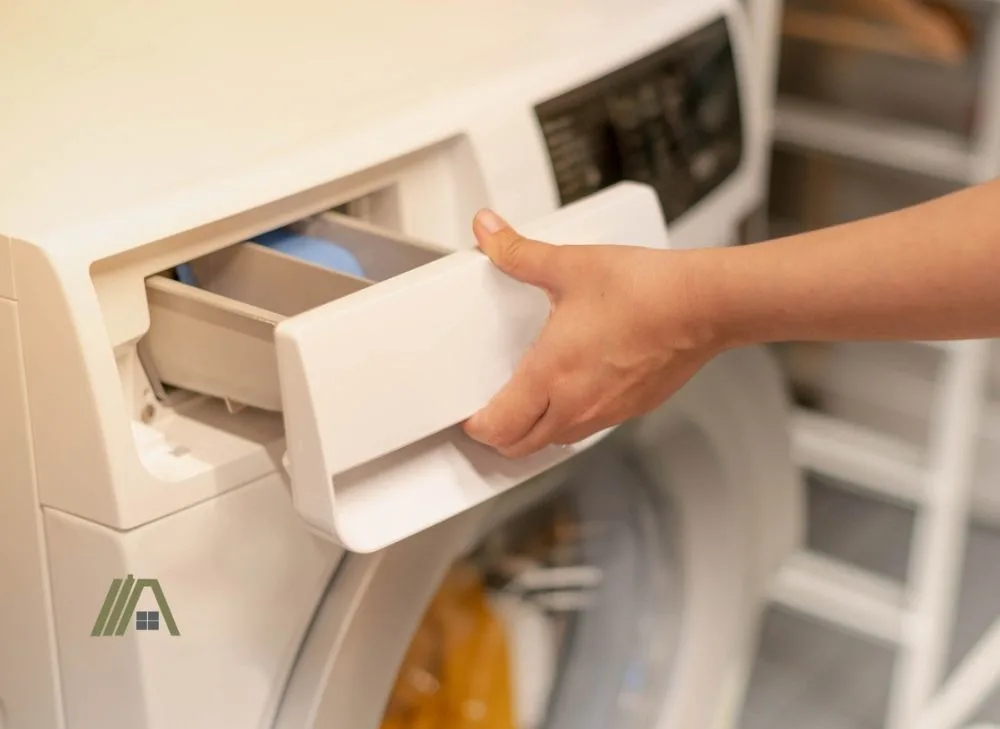
This section goes on to mention that dryer vents have to be at least 3 ft away from any openings into the house, such as windows, which means that running the hose out of a nearby window is not going to cut it.
International Residential Codes are only model codes that can be adopted into law by a particular jurisdiction. In other words, it is safe to say that using a dryer condenser box is not going to land you in jail.
Still, following building codes is in your best interest.
The IRC provides the foundation on which insurance companies assess risk. Compliance or lack thereof with building codes will affect your insurance premiums. A home not in accordance with the codes designed to keep it safe will be considered a higher risk.
Non-compliance with building codes will also probably decrease the price at which you can sell your house. Now, the dryer is a movable appliance as opposed to a fixture, so it’s not going to have the same impact as non-compliant wiring, for example.
However, houses compliant with the codes are less likely to see damage (that’s what building codes are largely for).
So, if a buyer sees your condenser box, they will start to wonder about hidden damage and other places where you might be violating the building codes. This can make them hesitant to purchase your house or they might try to drive the price down.
Moreover, let’s not forget the fines that contravening the building codes can incur.
Overall, using a condenser box with a dryer that is supposed to be vented outside has the potential to cost you a lot of money.
Exception: Those Designed to Be Ventless
There is an exception to the statement in Section M1502.2:
“listed and labeled condensing (ductless) clothes dryers.”
This exception exists because condenser dryers are able to effectively control their air through recycling.
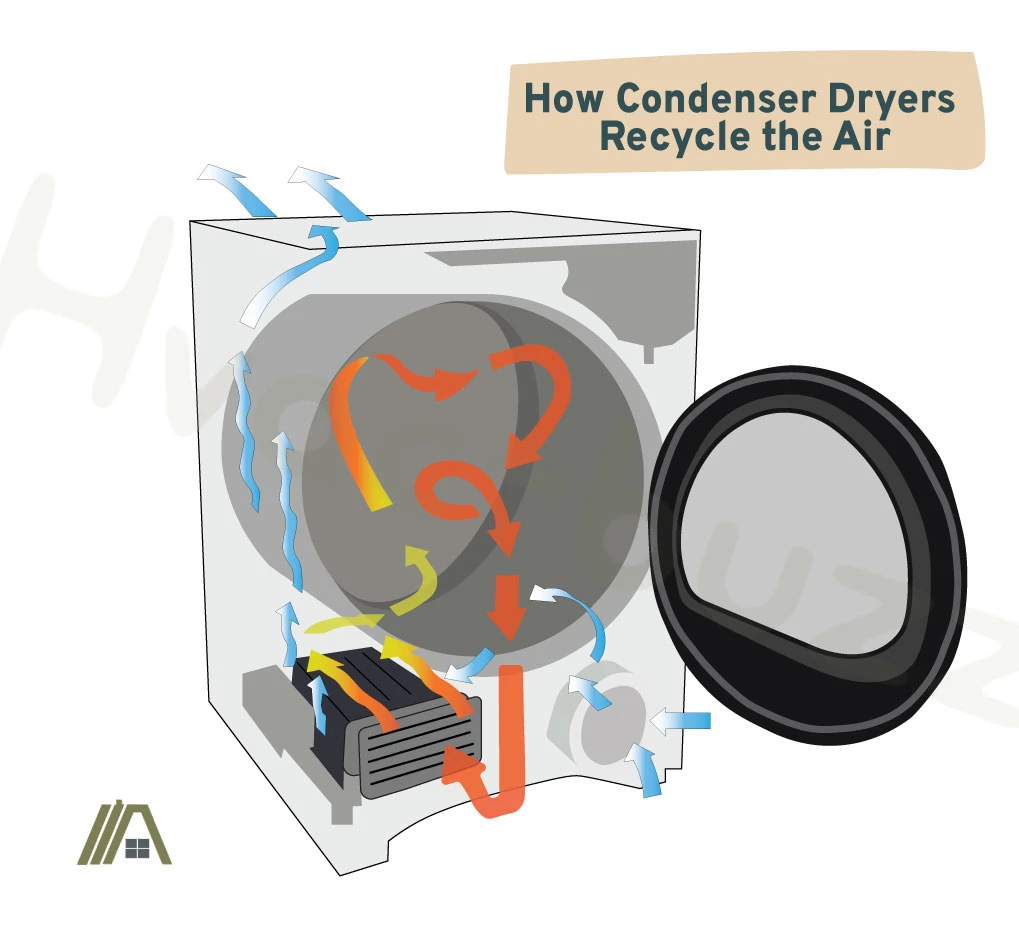
Instead of getting rid of hot and moist air through a hose like vented dryers, condenser dryers send their used air over cold condenser coils, which cause the moisture in the air to condense.
The condensate collects the moisture in a reservoir or pumps it out, and reuses the dry air.
These kinds of dryers (ventless) also have smaller load capacities than their vented counterparts. This contributes to why they are considered safe to use because less wet clothes in the dryer means less moisture released during a cycle.
Condenser dryers are an exception in the eyes of the IRC because they, even though ventless, safely control their moisture and heat emission.
Practical Drawbacks of Condenser Boxes
While building codes can sometimes seem hyper-technical and distant from their safety objectives, it is easy to see why they denied condenser boxes’ acceptability.
Condenser boxes’ lack of efficacy will more often than not damage your home, and, which is more, cause a safety hazard.
Water in the wrong places is destructive. The moisture that is not trapped by the condenser box will end up on the floor around it, on any walls nearby, and all over the room through humidity.
Any types of walls, with very few exceptions, exposed to water for too long will discolor, soften, and/or crack. Unless you have experience with drywall, you can expect the repair to cost you $50 to $75 per square foot. And prices are usually higher for other kinds of walls.
Tile, hardwood floors, carpet, manufactured and natural stone, and most other floors are also highly susceptible to damage from the use of condenser boxes. Along with the damage, wet floors also become slipping hazards.
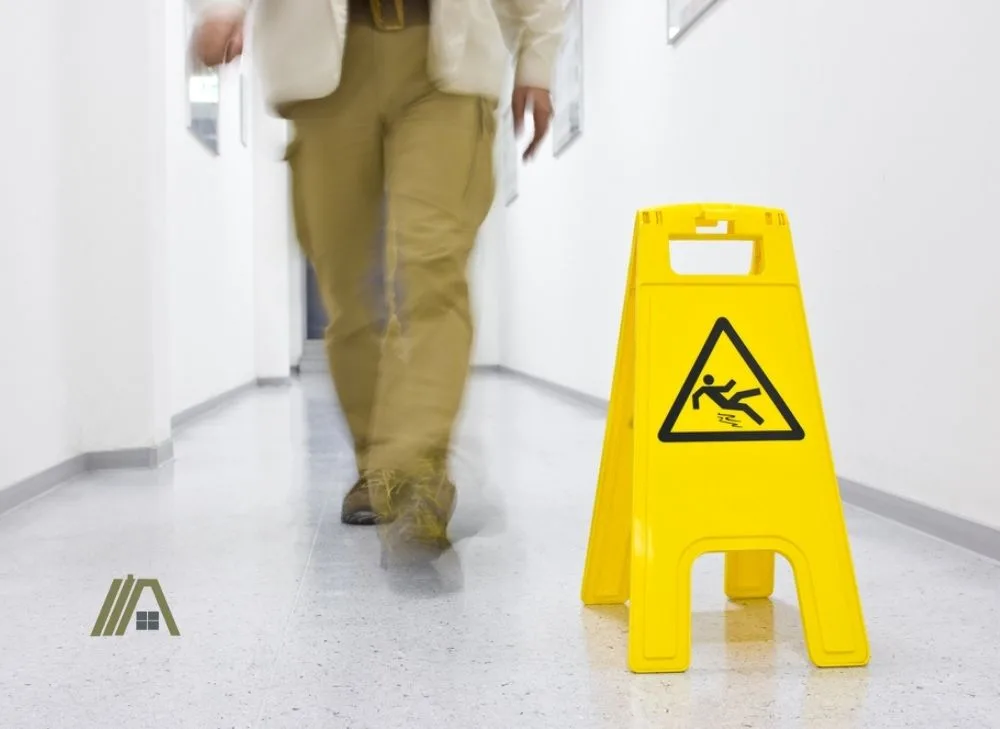
High levels of moisture on surfaces also promote mold growth, which gets into the air, making it odorous and toxic to breathe.
Speaking of toxic air, if you try to use a condenser box with a gas dryer, then you run the risk of introducing carbon monoxide into the room and the house. I don’t need to tell you how dangerous this is!
Some condenser boxes are so ineffective that they render the room they are in noticeably more humid—an obviously less critical drawback but worth considering.
Rather Buy a Condenser Dryer
If using your vented dryer with a hose leading outside won’t work for you, the best solution is purchasing a condenser dryer. Condenser boxes, while slightly better than simply venting your gas or electric in dryer inside, simply are not effective enough in trapping moisture.
Condenser dryers tend to be slightly more expensive but can make up for it in other areas.
You might directly decrease your insurance premium and increase the sale price of your home by buying a condenser dryer instead. You will avoid damage to your home and health and save yourself from the headaches that come with condenser boxes.
You can also opt for the slightly more expensive but highly efficient heat-pump dryer, another variation of the ventless dryer, and a fantastic option.
Although a small box only costing $10-$25 that is easy to install and claims to solve your dryer problem is enticing, it is most likely only going to further your troubles.
Sources
https://www.youtube.com/watch?v=AGpyrT2cfu8
https://askinglot.com/what-does-a-condenser-box-do
https://singletrackworld.com/forum/topic/tumble-dryer-condenser-box/
https://www.mumsnet.com/Talk/shopping/796620-those-condenser-boxes-you-put-on-the-end-of-vented
https://www.youtube.com/watch?v=adeyXwN73kQ
https://codes.iccsafe.org/content/IRC2021P1/chapter-15-exhaust-systems
https://www.thespruce.com/international-building-code-3972525
https://www.eesi.org/papers/view/the-value-and-impact-of-building-codes
https://thebuyguys.com/blog/selling-tips/4-ways-help-sell-house-fast-even-code-violations/
https://www.homeadvisor.com/cost/walls-and-ceilings/repair-drywall/
https://www.xavax.eu/00111341/xavax-condenser-box-for-vented-tumble-dryers
https://www.appliancesconnection.com/blog/vented-vs-ventless-dryers
